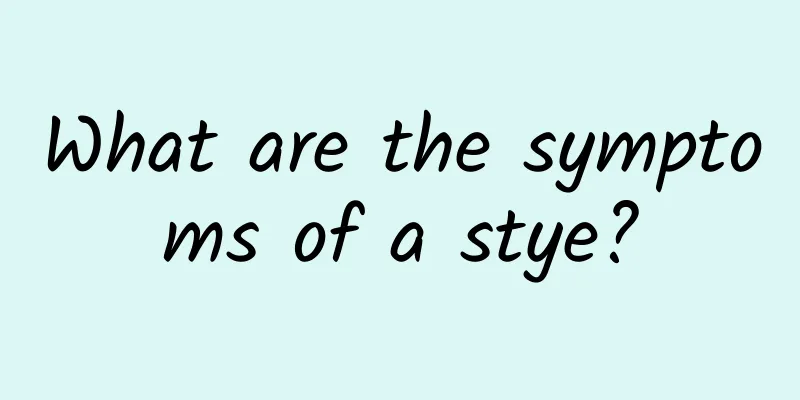What are the symptoms of a stye?

|
The so-called stye is a very common eye disease that often occurs in young people. When the disease occurs, local symptoms such as redness, swelling, and pain will appear. In severe cases, there will also be yellow pus. Experts say this disease is particularly stubborn and must be treated actively, otherwise the chance of recurrence is extremely high. 1. What is a stye? Stye, also known as hordeolum, has local redness, swelling, pain, nodules and yellow pus spots as its main clinical manifestations. Traditional Chinese medicine calls it earth ulcer or earth ulcer, commonly known as "stye", which is a common eye disease that anyone can suffer from, and it is more common in young people. This disease is stubborn and prone to relapse, and in severe cases may leave eyelid scars. There are two kinds of glands at the roots of eyelashes, which are also eye hairs: sebaceous glands and sweat glands. The tarsal plate, which serves as the support of the eyelid, has another gland in its inner layer called meibomian glands, which plays the role of moistening the eyeball. Stye refers to a disease in which these glands produce acute purulent inflammation due to bacterial infection, also known as hordeolum. When the sebaceous glands are infected, it is called an external hordeolum; when the meibomian glands are infected, it is called an internal hordeolum. 2. Stye is divided into two types: internal and external, and the symptoms of the two are different. 1. External hordeolum is an acute suppurative inflammation of the Zeiss gland. Initially, the eyelid margin is locally congested and swollen, and a nodule forms after about 2-3 days. There is obvious swelling, pain and tenderness. Later, the nodule gradually softens and a yellow pustule forms at the root of the eyelashes, which breaks through and discharges pus and heals quickly. If the pathogen is highly toxic, it may cause edema of the eyelids and nearby conjunctiva. The preauricular lymph nodes are swollen and tender, especially in the lateral canthus. Severely ill children may have systemic symptoms such as chills and fever. 2. Internal wheat is an acute suppurative inflammation of the meibomian glands. Its clinical symptoms are not as severe as those of external hordeolum because the inflamed meibomian glands are surrounded by firm meibomian tissue. Yellow pus is often faintly visible on the surface of the congested palpebral conjunctiva, and may break through and discharge pus into the conjunctival sac on its own. There may be a slight bulge and congestion at the opening of the meibomian gland, and pus may be discharged along the meibomian gland duct. In a few cases, pus may be discharged from the skin through the duct. If the tarsal plate cannot be penetrated and the pathogen is highly toxic, the inflammation will expand, invade the entire tarsal plate tissue, and form an eyelid abscess. 3. How to treat stye Apply local hot compress to promote suppuration. Mild inflammation can also disappear completely after hot compress. Systemic and local antibiotic treatment can promote the disappearance of inflammation. Penicillin antibiotics can be taken orally, injected intramuscularly or intravenously, and they are very effective against pyogenic bacteria. Eye drops can be applied topically, generally 0.25% chloramphenicol eye drops are sufficient. If there is a lot of secretion, rifampicin eye drops can be used for better results. Children can apply chloramphenicol eye ointment after falling asleep. Using an alcohol cotton ball to wipe the base of the eyelashes is very effective in treating styes. When children complain of itchy eyelids, redness, swelling or pain, parents can immediately use an alcohol cotton ball to wipe their eyelashes. Keep your eyes closed when wiping, and use an alcohol cotton ball (not too wet, squeeze out some alcohol if it is too wet) to gently rub back and forth at the root of the eyelashes a few times. Your eyes will feel hot after rubbing (do not open your eyes when hot, otherwise the alcohol will penetrate into your eyes and cause eye pain), and then open your eyes after the heat has passed. Just apply it 2-3 times a day to reduce swelling. |
>>: What should I do if I have more and more white hair?
Recommend
What should you pay attention to before donating blood?
Donating blood is a good public welfare behavior....
TCM treatment of irritable bowel syndrome
Irritable bowel syndrome is a type of gastrointes...
What causes cervical spondylosis? Two key factors
There are many adverse factors that cause cervica...
The role and efficacy of red head K
Many people don’t know about red-headed K. It is ...
Can I eat grapes after taking Chinese medicine?
Nowadays, people often choose to use traditional ...
Four first aid methods for tracheal foreign body! Do you understand?
Tracheal foreign bodies are a common childhood ac...
What is the reason for the red spot on the tip of the baby's tongue
If there are red spots on the tip of the baby'...
Constant nausea and retching
The stomach is actually a fragile digestive organ...
A prickly-heat-like rash that is very itchy
Prickly heat is a skin disease that infants and y...
Should I fill my broken deciduous teeth?
Before a child's teeth change, they are decid...
Will small breasts affect sex life?
There are many factors that affect the harmony of...
Bloating on the right side of the belly button
I believe that many people have experienced abdom...
The efficacy of ginger plaster
What we call ginger paste is a paste-like substan...
What is diaper dermatitis? What causes diaper dermatitis?
Diapers can cause neonatal diseases, the most com...
Warming stomach soup, these four warming stomach and cold-relieving soups are worth recommending
Pepper"text-align: left; text-indent: 2em;&qu...









